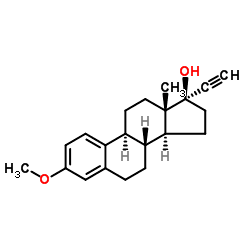MedlinePlus a601050 ATC code none CAS ID 72-33-3 | Routes ofadministration Oral Molar mass 310.43 g/mol | |
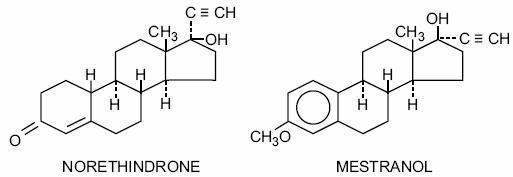 | ||
AHFS/Drugs.com International Drug Names Legal status In general: ℞ (Prescription only) Synonyms CB-8027, EE3ME, L-33355, RS-1044; 17α-Ethynyl-3-(methyloxy)estra-1,3,5(10)-trien-17β-ol | ||
Estudi te ric del rotor de mestranol
Mestranol (INN, USAN, BAN, JAN) (brand names Devocin, Ovastol, Tranel), also known as ethinylestradiol 3-methyl ether (EEME), is a synthetic, steroidal estrogen that has been widely used medically. It was employed as the estrogen component in many of the first oral contraceptives, such as mestranol/noretynodrel (brand names Enovid, Enavid), and is still in use today. It was also a component of Ortho-Novum, Ortho-Novin, Femigen, and Norbiogest. In addition to its use as an oral contraceptive, mestranol has been used as a component of hormone replacement therapy.
Contents
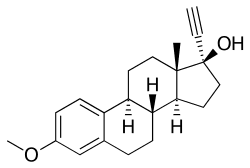
Pharmacology
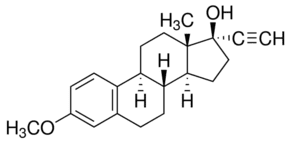
Mestranol is the 3-methyl ether of ethinylestradiol, and is a biologically inactive prodrug of ethinylestradiol to which it is demethylated in the liver with a conversion efficiency of 70% (50 µg of mestranol is pharmacokinetically bioequivalent to 35 µg of ethinylestradiol, or ethinylestradiol being about 1.7 times as orally potent by weight as mestranol).
History
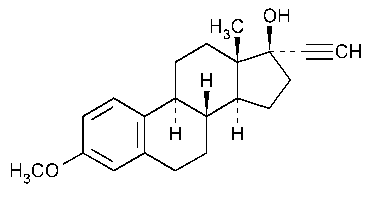
In April 1956, noretynodrel was investigated, in Puerto Rico, in the first large-scale clinical trial of a progestogen as an oral contraceptive. The trial was conducted in Puerto Rico due to the high birth rate in the country and concerns of moral censure in the United States. It was discovered early into the study that the initial chemical syntheses of noretynodrel had been contaminated with small amounts (1–2%) of the 3-methyl ether of ethinylestradiol (noretynodrel having been synthesized from ethinylestradiol). When this impurity was removed, higher rates of breakthrough bleeding occurred. As a result, mestranol, that same year (1956), was developed and serendipitously identified as a very potent synthetic estrogen (and eventually as a prodrug of ethinylestradiol), given its name, and added back to the formulation. This resulted in Enovid by G. D. Searle & Company, the first oral contraceptive and a combination of 9.85 mg noretynodrel and 150 μg mestranol per pill.
Around 1969, mestranol was replaced by ethinylestradiol in most or all combined oral contraceptives due to widespread panic about the recently uncovered increased risk of venous thromboembolism with estrogen-containing oral contraceptives. The rationale was that ethinylestradiol was approximately twice as potent by weight as mestranol and hence that the dose could be halved, which it was thought might result in a lower incidence of venous thromboembolism. Whether this actually did result in a lower incidence of venous thromboembolism has never been assessed.
